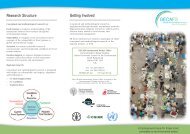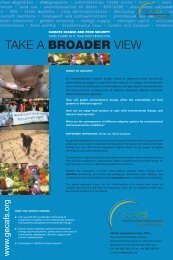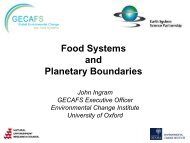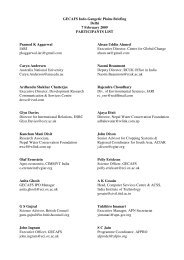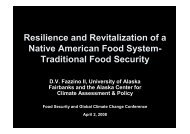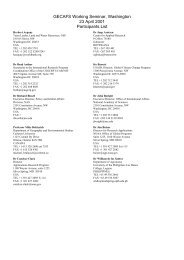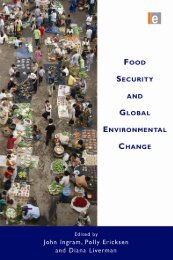From Food Production to Food Security - Global Environmental ...
From Food Production to Food Security - Global Environmental ...
From Food Production to Food Security - Global Environmental ...
- No tags were found...
Create successful ePaper yourself
Turn your PDF publications into a flip-book with our unique Google optimized e-Paper software.
Establishing institutional buy-in for GEC/food security research at regional levelResearch partnersIn addition <strong>to</strong> identifying a number of researchers who need <strong>to</strong> come <strong>to</strong>gether <strong>to</strong> bring thenecessary range of skills, effective GEC/food security research needs the close involvemen<strong>to</strong>f other stakeholders in planning and delivery. While the need for such involvement may befully accepted, it can be hard <strong>to</strong> identify the right partners and even harder <strong>to</strong> engage themmeaningfully. One way <strong>to</strong> help is <strong>to</strong> try <strong>to</strong> identify existing institutions which individuallycan fulfil different key roles in the research. These could, for instance, help <strong>to</strong> providescientific visibility and credibility within the region, or act as ‘boundary organizations’between the main research endeavour and other, more distant stakeholder communities, e.g.individual farmers. Establishing institutional buy-in from a range of stakeholders can add apowerful dimension <strong>to</strong> the research itself, and can also be very useful in outreach as suchpartners are often well connected <strong>to</strong> a wide range of beneficiaries. Posing a clear question,and drafted in terms <strong>to</strong> which potential partners can easily relate (e.g. ‘how can SouthernAfrican food systems be adapted <strong>to</strong> reduce their vulnerability <strong>to</strong> GEC?), helps both attractinterest and identify the role each can play. Box 5 shows how a range of stakeholders thus‘bought-in’ <strong>to</strong> a GEC/food security research question in the region. The signing ofMemoranda of Understanding (MoUs) and/or the formal endorsement of research plans canbe a powerful way of demonstrating this buy-in <strong>to</strong> other potential stakeholders, includingdonors.DonorsSeveral major organizations are now embracing the food systems concept for advancing foodsecurity research at regional level. Notable examples include the FAO (2008a), UKgovernment (Defra, 2008), European Science Foundation (ESF, 2009), Dutch government(NWO, undated) and the CGIAR’s new initiative ‘Climate Change, Agriculture and <strong>Food</strong><strong>Security</strong>’ (CCAFS, 2009). Despite this, raising funds for GEC/food security research atregional level is not easy. This can be due <strong>to</strong> a number of fac<strong>to</strong>rs.First, donors are most often mandated <strong>to</strong> operate on a bilateral basis at a national level andefforts <strong>to</strong> ‘regionalize’ projects generally has <strong>to</strong> involve a synthesis across multiple projectsas they come <strong>to</strong> an end. Also, regional-level projects, and especially those that try <strong>to</strong> linkacross spatial and/or temporal levels, can be deemed <strong>to</strong>o unfocussed.Second, research on food security, let alone when coupled with GEC issues, is highlycomplex and full of uncertainties. Research designed <strong>to</strong> ‘grasp the nettle’ is therefore highlycomplex and involves a large number of parameters and collabora<strong>to</strong>rs. While it might addressthe stated aims of development agencies better than research on, say, food production, theinherent complexity means it is hard <strong>to</strong> fit within funding portfolios (which might bestructured in terms of agriculture development, policy, governance, science, etc.), and is alsodeemed ‘high risk’.101



